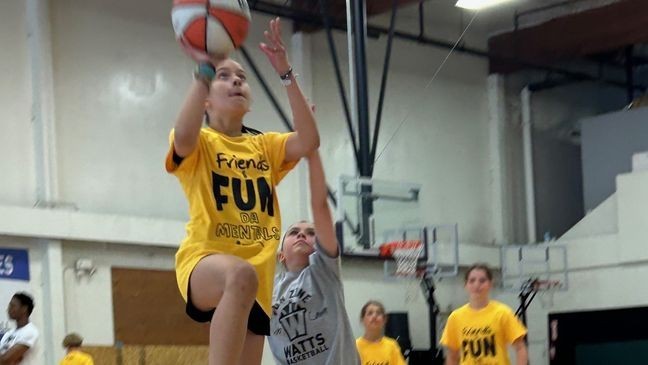Since stepping onto the court for the Indiana Fever as the No. 1 overall pick in the 2024 WNBA Draft, Caitlin Clark has done more than just score—she has completely shifted the landscape of women’s basketball in America. Dubbed the “Caitlin Clark effect,” her influence extends far beyond stats. She has ignited a surge in attendance, TV viewership, merchandise sales, and cultural relevance, forcing the WNBA—and U.S. sports culture—to take notice.
1. 🎯 A Rookie Sensation Transforms the WNBA
Clark’s transition from NCAA icon to WNBA phenomenon began with a bang. Averaging approximately 19 points, 8 assists, and 5 rebounds in her rookie season, she not only drew acclaim on the court but also captured hearts and cameras off it. Her collegiate stardom—marked by record-breaking NCAA viewership of 18.9 million—translated into instant professional stardom. The Fever quickly went from the bottom of the attendance ranks in 2023 (roughly 4,000 fans per game) to an astonishing 17,000+ average in 2024
To put this into perspective:
- Attendance skyrocketed by over 300%, from around 4,000 to 17,036 fans per home game
- In some venues, games featuring Clark drew more than 20,000 fans, including a record 20,711 fans at the Fever’s season finale
- WNBA attendance league-wide jumped 48%, with six teams surpassing 10,000 fans per game—something unthinkable before Clark’s arrival
2. 📺 Television Ratings Boom
Clark’s effect has translated into massive TV ratings too. In Q2 and beyond:
- The WNBA saw 1.32 million viewers on average across ABC, ESPN, and CBS—a nearly 3x increase over last year
- Games featuring Clark consistently hit millions:
- Opening Night vs. Connecticut Sun drew 2.12 million viewers
- Other matchups exceeded 2.3 million views (e.g., Fever vs. Sky on CBS)
- The Fever’s season finale set the WNBA record for viewership with 20,711 in attendance, making it the most-watched game in league history
Caitlin Clark rapidly became a national draw—on par with top NBA matchups. ESPN even reported WNBA millennial fans tuning in to games they wouldn’t normally watch simply to see her play
3. 🛍️ Commerce, Sponsorship & Fantasy Leagues
Clark’s influence has rippled through revenue channels beyond ticket and viewership stats:
- Merchandise: Jersey and apparel sales skyrocketed—WNBA store revenue rose over 236%, with Clark’s No. 22 leading the pack
- Ticket prices: Fever home game tickets averaged around $110, far above the league’s average of $79
- Economic impact: Estimates suggest Clark contributed $82.5 million to Indianapolis’s consumer spending, bumping Fever value to $370 million, second only to New York
- Sponsorships: Major brands catapulted behind Clark, including a reported $28 million Nike deal, further energizing the league’s commercial appeal
- Fantasy & betting: WNBA betting volume spiked over 150%, with Clark as the central figure, and daily fantasy participation climbed sharply
Together, these factors show she’s not just a player, she’s a movement—transforming the WNBA into a financial juggernaut.

4. 🌍 Public & Cultural Impact
Clark’s arrival has elevated the cultural perception of women’s sports:
- Media comparisons liken her ascendancy to Michael Jordan in the NBA
- Fans and analysts alike credit her with bringing mainstream entertainment value to women’s basketball—reigniting excitement across demographic lines .
- Yet her meteoric rise hasn’t been without friction—some veteran fans and players—like Angel Reese—feel overshadowed, stirring both fan fervor and occasional conflict
- Viewers have voiced both admiration and concern via social and traditional media. Reddit’s WNBA subreddit erupted: “She was the first player to get me into the W… now I have so many favorite teams”
5. 🏟️ The Franchise Model & Expansion Ripples
Clark’s impact forced operational changes across the league:
- The Dallas-Wings vs. Fever game moved to a 20,000-seat NBA arena due to extraordinary demand
- Six teams shifted Fever games to larger venues even without Clark—demonstrating she’s elevated the WNBA from niche to mainstream
- The Indiana Fever was chosen to host the 2025 WNBA All-Star Game, a first in the franchise history—an honor tied directly to Clark’s draw
These venue and scheduling shifts marked a new operating paradigm for the league.
6. 🏆 On-Court Disruption & Transitional Challenges
Clark’s transition hasn’t been seamless on the hardwood:
- The Fever were inconsistent in 2025, sitting at 9–9, even with Clark averaging 18.2 pts and 8.9 assists
- Clark missed several games due to a groin injury—during which road attendance dropped over 34%, underscoring her central role .
- Tensions have arisen. A hip-check foul and bench celebration by Angel Reese sparked debates over hostile — and sometimes toxic — fan behavior .
- While the WNBA works to maintain decorum with anti-harassment campaigns and robust officiating, debates continue over how to preserve civility amid surging popularity
7. 📅 Looking Ahead: Legacy & Growth
As the WNBA enters the 2025 All-Star season—with Clark earning the most fan votes (1.29M+) and named Eastern Conference captain—the league must balance her star power with sustainable growth.
Key considerations:
- CBA Negotiations: The league is in talks for a new Collective Bargaining Agreement. Players are pushing for better compensation— amplified by the increased revenues and viewership drawn by stars like Clark
- Cultural Equilibrium: While Clark draws new audiences, retaining the WNBA’s core values—especially diversity, equity, and inclusion—is vital .
- Deepening the League: Can other teams and players build their own breakout moments? Continued success will require more than one star .
8. 🔍 Bottom Line
Caitlin Clark has done more than rejuvenate one franchise—she’s elevated the entire league. Through staggering jumps in attendance, ratings, commerce, and cultural relevance, she’s helped propel the WNBA into mainstream prominence. But with celebrity comes complexity—on-court tension, behavioral challenges, and the balancing act between growth and identity.




